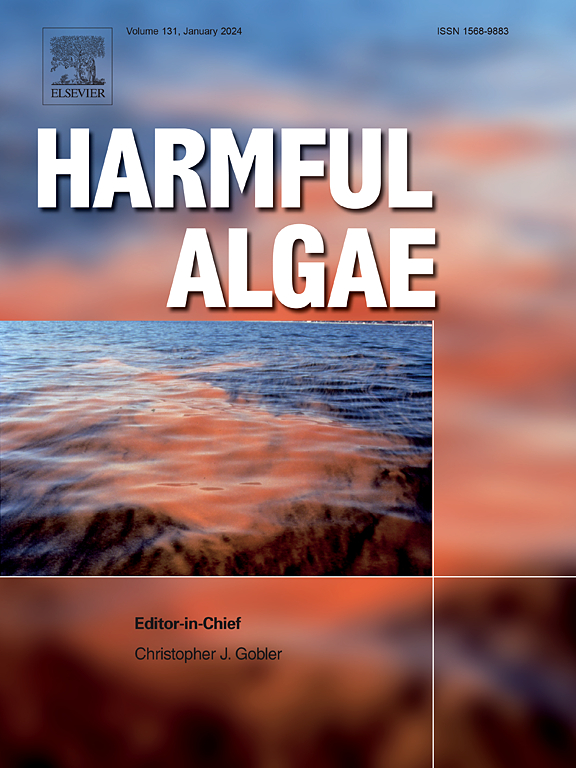贻贝养殖场对有害藻华治理的反应是由生产规模决定的:对公平蓝色经济的影响
IF 4.5
1区 生物学
Q1 MARINE & FRESHWATER BIOLOGY
引用次数: 0
摘要
小规模水产养殖对于平衡环境健康、经济增长和社会公平至关重要。然而,有害藻华(HABs)的频率日益增加,通常被称为赤潮,对水生生态系统和人类福祉构成重大风险,威胁到该部门的生产力。本研究调查了赤潮导致的关闭对世界第二大贻贝产业智利贻贝养殖的影响,重点研究了养殖场规模如何影响恢复力和适应能力。利用一个19年(2003-2021年)的数据集(涵盖小型(3公顷)、中型(3 - 8公顷)和大型(8公顷)贻贝养殖场,我们分析了有害藻华关闭的时空分布及其对贻贝出口量的影响。利用广义加性混合模型(GAMMs),我们发现小型农场虽然试图在关闭后快速恢复,但更容易受到长期经济压力的影响,这主要是由于获得适应性资源的机会有限和市场价格波动。另一方面,较大的农场表现出延迟但稳定的复苏,受益于优越的空间定位和获得资金的渠道。虽然该行业在区域层面上显示出持续增长,但我们的分析表明,当地的反应存在不对称、规模依赖模式,其中小生产者更容易受到意外气候事件和市场波动的影响。鉴于气候变化导致的赤潮日益频繁,我们的研究结果强调了在蓝色经济中进行公平治理的必要性,以防止小型和大型生产者之间的不平等扩大。政策建议包括加强监测系统,增加小农获得资金和技术资源的机会,以及市场多样化以提高抵御环境破坏的能力。本文章由计算机程序翻译,如有差异,请以英文原文为准。

Responses of mussel farms to harmful algal bloom governance are shaped by the scale of production: Implications for equitable blue economy
Small-scale aquaculture is essential to balance environmental health, economic growth, and social equity. However, the increasing frequency of Harmful Algae Blooms (HABs), commonly known as red tides, present a significant risk to both aquatic ecosystems and human well-being, threatening the productivity of the sector. This study investigates the impact of HAB-induced closures on mussel farming in Chile, the world's second-largest mussel industry, with a focus on how farm size influences resilience and adaptive capacity. With a 19-year dataset (2003–2021) covering small (<3 ha), medium (3–8 ha), and large (>8 ha) mussel farms, we analysed the temporal and spatial distribution of HAB closures and their effects on mussel export volumes. Using Generalized Additive Mixed Models (GAMMs), we reveal that small farms, while attempting rapid post-closure recovery, are more vulnerable to prolonged economic stress, primarily due to limited access to adaptive resources and fluctuating market prices. Larger farms, on the other hand, demonstrate a delayed but stable recovery, benefiting from superior spatial positioning and access to capital. While the industry showed sustained growth at the regional level, our analysis demonstrated an asymmetric, size-dependent pattern on local responses, where small producers are more vulnerable to unexpected climatic events and market fluctuations. Given the increasing frequency of HABs due to climate change, our findings underscore the need for equitable governance in the blue economy to prevent widening inequalities between small and large producers. Policy recommendations include enhanced monitoring systems, increased access to financial and technical resources for small-scale farmers, and market diversification to improve resilience against environmental disruptions.
求助全文
通过发布文献求助,成功后即可免费获取论文全文。
去求助
来源期刊

Harmful Algae
生物-海洋与淡水生物学
CiteScore
12.50
自引率
15.20%
发文量
122
审稿时长
7.5 months
期刊介绍:
This journal provides a forum to promote knowledge of harmful microalgae and macroalgae, including cyanobacteria, as well as monitoring, management and control of these organisms.
 求助内容:
求助内容: 应助结果提醒方式:
应助结果提醒方式:


